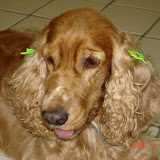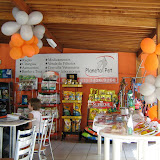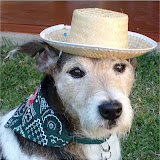I recommend enrolling you and your new dog in a training class after you get your dog. This will help you both bond and help you through those first couple months when problems may arise that you don't know how to handle.
As far as rawhide goes - too much of anything is bad for a dog, and something now and again will rarely harm a dog, but you do need to be careful with rawhide. The ability of a dog to tolerate it, really depends on the dog's chewing habits. A dog that is a voracious chewer could bite off larger chunks of rawhide that could get stuck in the throat or lodged in the bowels causing an obstruction. A dog that chews it carefully can have them when monitored, being sure to take it away when you get to the last slab - again because often that is swallowed whole. I've had to pull slimy rawhide from the back of my dog's mouth several times, so I'm careful to remove it from them when it gets down to a swallowable piece - and I make sure they only have rawhide when I'm present. A Kong stuffed with goodies is a great treat for unsupervised play. If you buy rawhide, make sure it's made in the USA, foreign rawhide is preserved with things that you don't want your dog consuming. IMO - the best treat for your dog is a simple knuckle or marrow bone bought from the local grocery store or butcher. They're cheap, the dogs LOVE them and it keeps their teeth remarkably white. You feed them raw, and if you're concerned about blood on the carpet - give it to your dog when it's in a crate or outside to start - they'll have the meat off the outside of the bone in about 20 mins, and then spend a lot of time working on the marrow in the middle. Don't be surprised if they make your dog throw up the first couple times, but their system will adjust to them quickly in most cases. Mine get one of these every 2-3 days and LOVE them - keeps them busy for hours. Matter of fact, my female is chewing on a knuckle bone right now that I gave them last night during "relax" time.
For most dogs, food is simply a matter of preference. Every dog food on the market will provide your dog with ample nutrition and 99% of dogs will do just fine on just about any dog food. Don't get sucked into "designer" foods. Read the labels and be an educated consumer. When shopping, your first ingredients should be meat, not grains. Corn is almost indigestible, and basically is filler - so if you buy a food with corn (which is prevalent in less expensive foods), then just know that you will have higher poo volume which means less food is being absorbed by your dog and more food is going on the ground - so cheaper isn't always a bargain - you can feed less of a better quality food (without corn) and get the same results. Basically - pick a food that you and your dog both like, and stick to it. Switching foods can cause digestive upset and can create a picky eater. I prefer not to feed table scraps - it makes it harder to control a dog's weight, can cause picky eating and can also create begging problems.
Look into clicker training - it can be fun for you and the dog, and can also accelerate learning.
FYI - March is a great time to get dogs in the shelter, that's about when all the cute fuzzy puppies that were given as gifts at Christmas reach the lanky and not so cute chewing and rebellious stage - when many are then surrendered to shelters.
Last but not least - get a crate for your new dog. This will help insure your dog's safety as well as the safety of your belongings. Dogs usually grow to love their crates and will go there when they are feeling stressed or just need some time to relax. My male, who is no longer confined to his crate, often sleeps in there during the day and even spends all night in there, even though the door is open. It makes housebreaking easier, and it makes it easier if you travel with your dog. It will also make your dog more comfortable if he needs to spend time at a vet or boarding kennel if he is already used to spending time in a crate.
[Escrito por Denise Parsons em 15 de janeiro de 2006 para a lista Petdogs-L do Yahoo Groups]
There are pros and cons on getting a dog in March. If you get an adult, and you don't mind being outside in the cold, it shouldn't matter much. I personally vowed that I would never have a winter puppy b/c I don't like standing out in the cold the necessary time it takes to work with a puppy in housetraining, not to mention some of the puppies not liking it much better than I. It's a personal choice.
Contrary to popular belief, there is a difference between quality food and junk food. There is with humans and there certainly is with dog foods. Having said that, I do suggest that people buy the best food they can afford. The dog will survive on Wal-mart's Ole Roy or any other grocery store dog food but I don't recommend it unless that's all someone can afford. I would rather see someone spend less money on expensive dog treats and toys and have better quality dog food but that's my personal opinion. The thing here about food is that we don't know if a dog on lower quality food (which I call junk food) who lived a happy, healthy life of 12 years would have lived to 15 or 16 on a better quality food. You have to decide on that yourself.
Diet is important. Two things that I do not want to cut corners, one is medical and the other is diet. I feed a high quality diet to my dogs and I definitely notice a difference in their skin and coat. The sad truth is that I will never know if one of my dogs would have lived as long if I fed grocery store food. I do, however, know that my dogs are living longer since I changed than my dogs of 25 years ago but I have no proof that they would have gone at that age regardless of diet. My suggestion is to really study canine nutrition. Decide for yourself. I know that I do not want my dogs eating by-products so I won't buy the cheap foods which all contain that. I prefer human-grade ingredients after hearing all the horror stories I hear from rendering plants and what goes into some dog foods.
As far as rawhide goes, I don't use it. I've pulled too many slimmy pieces out of my dog's mouth when I've been right in the room with them. So much for supervision. I want to avoid obstruction, which brings me to the point of puppy proofing your house (even if the dog is an adult). They can ingest some things that you wouldn't even think of. Each dog is different in terms of what might turn them on....wood, plastic, cloth, etc. I feed knuckle bones, bully sticks and frozen stuffed Kongs as well as Nylabones that my dogs can't get a piece off, even my tough chewer rottie.
Depending on the age of the dog you adopt, you might have to start from scratch with housetraining and you might not. If you get a dog from unknown origin, you won't have the benefit of talking to the breeder about substrate and you'll have to figure it out by trial and error.
I do NOT recommend a flexi lead (or any retractable lead) to be used on a new dog who is not trained or been introduced slowly to it. They can be very dangerous to the novice dog and the novice handler. Get a long line made of cotton web. For safety reasons, I recommend using a harness with the long line and even the long line needs to be introduced slowly so that the dog won't run all the way to the end and sustain an injury with the sudden jolt, thus no collar recommendation by me. The thing with the flexi leads is that they can rip your hand if you ever grab it during an emergency or it can wrap around a dog's leg and sever it. I've seen horrible accidents with children and the flexi lead. They need to be used with a lot of care and safety being the most important. I suggest them for experienced dog and handlers only.
As far as training goes. I can give you my recommendation on books and videos where you can work alone but I suggest a professional trainer who will work with you one on one or join a group class locally. Not everyone does well with self-help books. I strongly suggest clicker training. If you learn clicker training, you can teach a ton of tricks with the basic principle and you won't need detailed instructions as to how to train each particular trick or obedience exercise like sit, down, stand, stay, etc. The methodology is the same. You shape it, capture it or lure it, but shaping is the best (imo) and is more apt to stay with the dog long term. With clicker training, the dog doesn't sit waiting for instructions as with 'traditional' trining. The dog learns to offer behaviors that are clickable, thereby being rewarded. The basic principle is that you reward the behavior you like. You ignore the behavior you don't like (iow, no corrections) and you manage (deny access to) the behavior you can't ignore until you get it trained (like chewing the sofa, etc.). You can also learn a lot if you join one of the clicker lists. A clicker savvy dog can learn behaviors much faster than most traditionally trained dogs (imo). Although one might use some corrections in training, they are never physical ones if the trainer is using clicker training properly (as it was designed).
[Escrito por Cher McCoy em 16 de janeiro de 2006 para a lista Petdogs-L do Yahoo Groups]
















%5B2%5D+532.jpg)

Nenhum comentário:
Postar um comentário